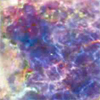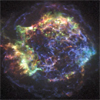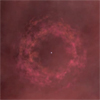CXC Home | Search | Help | Image Use Policy | Latest Images | Privacy | Accessibility | Glossary | Q&A
Movie of Chandra Images Evolving Over Time
Quicktime MPEG
This movie has been created from a series of X-ray observations from Chandra of Cassiopeia A (Cas A) over eight years. It begins with a full-field view of Cas A, cycling through the movie several times. The camera then zooms into three different areas of Cas A where evolution of different features can been seen. This movie - the first of its kind for a supernova remnant - reveals new details about the supernova explosion and its remnant seen today.
[Runtime: 02:00]
Quicktime MPEG
This movie has been created from a series of X-ray observations from Chandra of Cassiopeia A (Cas A) over eight years. It begins with a full-field view of Cas A, cycling through the movie several times. The camera then zooms into three different areas of Cas A where evolution of different features can been seen. This movie - the first of its kind for a supernova remnant - reveals new details about the supernova explosion and its remnant seen today.
[Runtime: 02:00]
(Credit: NASA/CXC/SAO/D.Patnaude et al.)
Brief Time-lapse Movie of Cassiopeia A
Quicktime MPEG
This brief movie of X-ray data from Chandra of Cas A was made by combining observations taken in January 2000, February 2002, February 2004, and December 2007. In these images, the lowest-energy X-rays Chandra detects are shown in red, intermediate energies in green, and the highest energies in blue. Scientists have used the movie to measure the expansion velocity of the leading edge of the explosion's outer blast wave (shown in blue). The researchers find that the velocity is 11 million miles per hour, which is significantly slower than expected for an explosion with the energy estimated to have been released in Cas A.
[Runtime: 00:20]
Quicktime MPEG
This brief movie of X-ray data from Chandra of Cas A was made by combining observations taken in January 2000, February 2002, February 2004, and December 2007. In these images, the lowest-energy X-rays Chandra detects are shown in red, intermediate energies in green, and the highest energies in blue. Scientists have used the movie to measure the expansion velocity of the leading edge of the explosion's outer blast wave (shown in blue). The researchers find that the velocity is 11 million miles per hour, which is significantly slower than expected for an explosion with the energy estimated to have been released in Cas A.
[Runtime: 00:20]
(Credit: NASA/CXC/SAO/D.Patnaude et al.)
Animation of a Supernova Explosion
Quicktime MPEG
This artist's animation shows the basics of a supernova explosion like the one that created Cas A. When a massive star runs out of fuel, it collapses onto itself and its remains are then expelled into the surrounding space. This expanding debris field is very hot and thus glows brightly in X-rays, which are detected by telescopes like Chandra. At the end of the animation, the view dissolves into an image of Cas A created from Chandra data.
[Runtime: 00:26]
Quicktime MPEG
This artist's animation shows the basics of a supernova explosion like the one that created Cas A. When a massive star runs out of fuel, it collapses onto itself and its remains are then expelled into the surrounding space. This expanding debris field is very hot and thus glows brightly in X-rays, which are detected by telescopes like Chandra. At the end of the animation, the view dissolves into an image of Cas A created from Chandra data.
[Runtime: 00:26]
(Credit: NASA/CXC/A.Hobart)
Return to Cassiopeia A (January 6, 2009)





